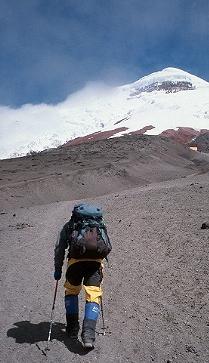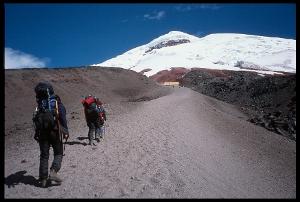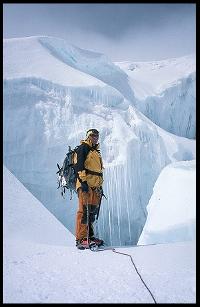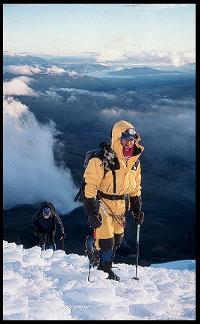|
 I
lifted one plastic boot and planted its steel crampons into
the snow with a styrofoam crunch. I took a deep breath. Fourteen.
Eleven more steps and I could rest again. I
lifted one plastic boot and planted its steel crampons into
the snow with a styrofoam crunch. I took a deep breath. Fourteen.
Eleven more steps and I could rest again.
It was
dark, the air was thin, and Billie Holiday crooned through
the ice-coated wires of my headphones about what a little
moonlight can do.
The night
clouds parted and the snowy flank of Cotopaxi, the highest
active volcano in the world, was bathed in a spectral light.
I was almost
exactly on the equator, three miles high in the heart of the
Ecuadorian Andes, with three thousand feet to climb before
dawn.
Ecuador
is slowly gaining fame as a high-altitude playground where
mountaineers can cut their teeth on peaks up to 20,000 feet
with relatively little expense or effort. Many of the climbs
are not technically difficult, but up here a world away from
the country’s sweltering rainforests and Pacific beaches,
even a walk in the snow is nothing to be taken lightly.
We had
met the day before in Quito, which at 9,375 feet is the second-highest
capital in Latin America. There were four climbers—my
friend Jeff and I, quiet David from England, in Ecuador to
adopt a daughter, and Adam, a talkative chemical engineer—and
two guides: copper-skinned Ramiro, who owned the climbing
company, and Juanito, who had a Wile E. Coyote doll strapped
to his backpack.
 The
perfect snow-capped cone of Cotopaxi poked above a layer of
clouds as we left the city smog for the Avenue of the Volcanoes,
Ecuador’s knobby Andean spine. The
perfect snow-capped cone of Cotopaxi poked above a layer of
clouds as we left the city smog for the Avenue of the Volcanoes,
Ecuador’s knobby Andean spine.
At 19,400
feet, Cotopaxi is the second highest mountain in Ecuador,
and by far the most popular to climb. Its name means "Neck
of the Moon" in Quechua, the language of the Incas, Ecuador’s
first inhabitants.
One of
the most destructive on the continent, Cotopaxi has a rap
sheet of over a dozen recorded eruptions. It last blew its
top in 1877, which was recent enough for it to be considered
the highest active volcano in the world.
A rough
cobbled track led toward the north side of the mountain past
cows and half-wild horses grazing in the intense equatorial
sun. We parked above the treeline and gasped our way up a
gravel slope to the climber’s refuge at 16,000 feet.
The stone building that smelled of exertion and starchy food.
Ramiro
took Jeff and I out onto the glacier for a short course in
traveling over ice and snow. He showed us how to walk diagonally
to keep from shredding our calves with the spikes of our crampons,
and demonstrated how to stop a sliding fall.
"If you
fall, get your head uphill and dig in with your ice axe, like
this." As I practiced, I wondered if I’d have the presence
of mind to do that as I careened down an icy slope in the
darkness with a brain starved for oxygen.
Back at
the refuge we ate dinner amid an Indiana Jones atmosphere
of candlelight and a murmur of languages. The plan was to
leave at 2 a.m., in time to be well up the mountain before
the sun started to soften the snow.
I fell
asleep hoping I had what it took—mostly determination
and luck—to be one of the one in ten that made the summit.
I woke what seemed like every few minutes gasping for breath,
my mouth so dry my tongue split.
We dressed
in the darkness, stuffed down a quick breakfast, and assembled
on the flagstone patio for a final gear check. Ramiro tied
Jeff and I to his rope and set off up the slope. I put on
my headphones and listened to Billie Holiday sing of starts
falling on Alabama as the headlamps of other groups bobbed
uphill in the darkness.
 We
hit the snowline within an hour and strapped on our crampons.
David had turned back mysteriously just above the refuge,
but the rest of us still felt strong. We
hit the snowline within an hour and strapped on our crampons.
David had turned back mysteriously just above the refuge,
but the rest of us still felt strong.
The sky
began to lighten to the east as we cut endless switchbacks
up the northern route pioneered in 1882 by Edward Whymper,
the first man to climb the Matterhorn. Robin’s-egg blue
gave birth to strips of lava, then half a skyful of flaming
feather clouds.
Soon our
guides’ slow but steady pace began to take its toll.
We were closing in on 18,000 feet, where the air holds half
as much oxygen as it does at sea level. I had the advantage
of a month in Ecuador already, but the rest had arrived more
recently and hadn’t had much time to acclimatize.
Jeff switched
to Juanito’s rope and I turned up the volume on McCoy
Tyner playing the piano like a man with twelve fingers. I
let the swinging chords fill my mind and drown out all thoughts
of stopping.
On non-technical
ascents like this, climbing is a much a mental challenge as
a physical one. The trick becomes knowing when to listen to
the inner voice begging you to stop, and when to ignore it
and push higher.
Ramiro
and I stepped over crevasses that fell into blackness and
climbed past ice caves glowing blue in the sun. The world
was nothing but snow and sky, purple shadows and the yellow
dot of Ramiro’s parka.
The incline
grew steeper the higher we climbed and the summit seemed to
recede into the wind-whipped air. Existence had narrowed to
a simple rhythm. Step. Gulp air. Plant ice axe. Repeat.
My head
pounded. I would have given anything to sit down in the snow
and stop, and probably would if I could hear my inner voice
more clearly. I turned up the volume.
Suddenly
the slope flattened and the trail ended at the lip of a vast
crater filled with clouds. Ramiro turned and grinned and congratulated
me for being the first person on top this fine morning.
I looked
around in a daze, grinning through my frozen beard.
My mouth
didn’t seem to work quite right, but I almost laughed
when Ramiro pulled out his cell phone to call the office and
tell them we had made it. This was his 143rd time
on top.
The wind
whipped the clouds apart to reveal peaks in every direction
as we snapped photos of each other, axes raised. Then we turned
and started down.
The descent
took less than two hours. The sun, still rising toward noon,
softened the snow and inspired us to strip off layer after
layer of clothing.  Wonderful oxygen filled the air. Wonderful oxygen filled the air.
We slid the last
thousand feet to the refuge on the seats of our pants, whooping
like cowboys.
TRIP ESSENTIALS
Cotopaxi is 50
km southeast of Quito, the capital of Ecuador, in the center
of a national park of the same name. It isn’t a technically
difficult climb, but it’s not for the inexperienced or
unprepared. Basic mountaineering gear is essential, along
with moderate climbing experience or the services of a trained
guide.
The best months
for climbing are December and January, followed by August
and September. You should definitely acclimatize with a week
or two in Quito (at 9,400 feet, the second highest capital
in the Americas) or higher before attempting the ascent. Ecuador
has plenty of smaller mountains for training climbs: try Atacazo,
Corazón, Guagua Pichincha, Ilaló, Imbabura,
or Pasachoa.
It costs $10 per
person to enter the park and another $10 to spend the night
at the José Ribas refuge, which is administered by
Alta Montaña in Quito (tel. 02-2254-798
aventurag@ch.pro.ec). The
two-story shelter has 70 bunk beds, lockers, cooking facilities,
running water, and snacks and water for sale.
There are dozens
of climbing companies in Quito that can take you to the summit
for $150-200 pp, all inclusive. Two of the best are Ramiro
Donoso’s Ecuadorian Alpine Institute at Ramirez
Dávalos 136 and Amazonas, tel. 011-593-2-565-465, fax
011-593-2-568-949, EAI@ecuadorexplorer.com,
www.ecuadorexplorer.com/eai,
and Safari Tours at Calama 380 and Juan León
Mera, tel./fax (800) 434-8182, 011-593-2-220-426, fax 011-593-2-223-381,
admin@safari.com.ec,
www.safari.com.ec.
You
can get the latest climbing conditions, along with just about
any other travel tidbit imaginable, from the South American
Explorers’ clubhouse in Quito at Jorge Washington
311 and Plaza, tel./fax 2-225-228, explorer@saec.org.ec,
www.samexplo.org.
Membership is $40 pp for a year ($70 for couples).
The best guidebook
to the country, of course, is my own Ecuador Handbook
(Avalon Travel Publishing, $16.95), which was fully
updated in 2000 to include the country’s recent switch
to the U.S. dollar.
Yossi Brain’s
Ecuador: A Climbing Guide ($16.95) and Mark
Thurber and Rob Rachowiecki's Climbing and Hiking
in Ecuador are available from The Mountaineers Books:
www.mountaineersbooks.org.
|